Steam
Universal Tank 2
2016-04-11-15:20
Ett snabbt nyhetsinlägg:
Fick precis reda på, via Google+, att ett spel jag följt i många år har en kickstarter.
Första delen (Tank Universal 1) har funnits på Steam tämligen lång tid.
Personligen har jag varit med ända sedan spelet betatestades.
Det är gjort av en enda person (Phil Jones) och har en otroligt cool Tron-liknande
design. I grunden är det ett hederligt Tankspel med tung retroinspiration.
Men man hittar också en allvarligare underton i berättelsen som binder ihop
spelets alla delar. Oavsett vilket är det ett cool projekt som förtjänar stöd.
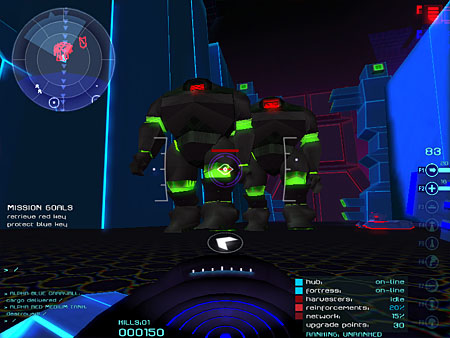
Tank Universal 2.
Länkar:
Kickstarter
Steam Greenlight
Spelets egen webbsida
TES3: Morrowind Wiki
2015-03-08-16:10
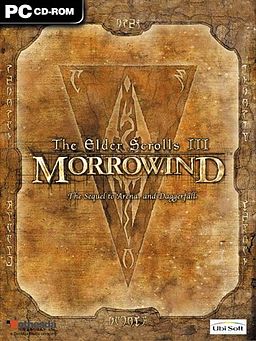
Read the full Article here: http://en.wikipedia.org/wiki/The_Elder_Scrolls_III:_Morrowind
The Elder Scrolls III: Morrowind is an open world fantasy action role-playing video game developed by Bethesda Game Studios, and published by Bethesda Softworks and Ubisoft. It is the third installment in The Elder Scrolls series of games, following The Elder Scrolls II: Daggerfall, and preceding The Elder Scrolls IV: Oblivion. It was released in North America in 2002 for Microsoft Windows and the Xbox. Well-received publicly and critically, with over four million sales[3] and more than 60 awards (including Game of the Year),[4] the game spawned two expansion packs for the PC: Tribunal and Bloodmoon. Both were eventually repackaged into a full set containing all three, Morrowind: Game of the Year Edition, which shipped on October 30, 2003, for both PC and Xbox.[5]
The main story takes place on Vvardenfell, an island in the Dunmer province of Morrowind, which lies in the empire of Tamriel and is far from the more civilized lands to the west and south that typified Daggerfall and Arena. The central quests concern the deity Dagoth Ur, housed within the volcanic Red Mountain, who seeks to gain power and break Morrowind free from Imperialreign.[6][7][8] Morrowind was designed with an open-ended free-form style of gameplay in mind, with less of an emphasis on the game's main plot than its predecessors. This choice received mixed reviews in the gaming press, though such feelings were tempered by reviewers' appreciation of Morrowind ' s expansive and detailed game world.
[..clip..]
Free-form design[edit]
Morrowind, following the tradition established by its predecessors in The Elder Scrolls series,[22] attempts to establish a completely free-form world, with little constricting boundaries on the player's actions. From the beginning of the game, players are put in a world where they are left to roam, steal, quest and explore, without necessarily following the main quest.[23] Lead Designer Ken Rolston, asked prior to Morrowind ' s release what he thought were the "core, untouchable design elements" of the Elder Scrolls series which "set them apart from other games", responded immediately: "Free-form experience."[24] In Rolston's view, the game's central plot is a chance to introduce the player to a cross-current of conflicting factions, background themes, and to the characters of the game, rather than the primary focus of the player's experience.[25] "Every TES game has to let you create the kind of character you want, and then do the things you want. We would never have a TES RPG force you to be a certain character or go down a certain path."[24]
To allow for this behavior, Morrowind, in addition to creating an extensive main quest, provides detailed discursive quests for a variety of factions, including various guilds, religious organizations and aristocratic houses, in addition to side-quests found by mere exploration.[26][27] Even the main plot itself may be undertaken in a number of ways. There are, in the words of critic Craig Lindley, "a very specific set of central plot points within this main plot. But the plot points are partially ordered: seven high level tasks must be completed, but their constituent sub-tasks...can be accomplished in any order, and this is repeated for the sub-tasks involved in those sub-tasks." The choices the player makes in their performance of these tasks thus become methods of character interpretation; a set of dramatic tools establishing the player's newly created self-identity.[28]
According to Gamasutra's Matt Barton, some have argued that these changes put Morrowind closer in spirit to the original Dungeons & Dragons tabletop game, where players take a more creative role in their play, and where players are left to decide for themselves the "right" action.[29] This is a view paralleled by Rolston, who has stated that "The goal of every TES game is to create something that resembles a pen and paper RPG on the computer."[24] The sheer number of quest possibilities, combined with what developer Ken Rolston identified as a lack of "narrative urgency", left many critics dissatisfied with the main plot. Ken Rolston later stated that the main quest might have been presented with greater force, in the style of the game's successor, The Elder Scrolls IV: Oblivion, without losing the free-form design of the series, but such concerns were not addressed prior to Morrowind ' s release.[30]
[..clip..]
Reception[edit]
The Elder Scrolls III: Morrowind was well received by critics. It was congratulated most frequently for its breadth of scope, the richness of its visuals, and the freedom it worked into its design. Alongside the compliments, however, came criticism that the game designers had overstretched themselves, leaving glitches in various spots, and made a game too taxing to be run on an average machine, with one reviewer calling it "a resource pig".[59] In a retrospective by 1UP.com, the breadth and open-endedness of Morrowind is suggested to have contributed to the decline of single-player RPGs on home computers by leading customers to MMORPGs, where they could have a similar experience.[80]
In spite of this, reviewers generally felt that the drawbacks of the game were minor in comparison to its strengths. IGN concluded that "Morrowind isn't perfect and its system requirements are huge; but its accomplishments outweigh any reservations."[77] GameSpot's review concluded with a similar summation. "Morrowind does have numerous drawbacks...But they're all generally minor enough that most anyone should be able to look past them...They'll otherwise find that Morrowind fulfills its many ambitious intentions. It's a beautiful-looking, sprawling, and completely open-ended game that allows you to play pretty much however you like”.[60]
[..clip..]
AlienGamer is a donor to Wikipedia Foundation. Are you?
If not, go HERE and put down a donation?
TES3:Morrowind
2015-03-08-15:08
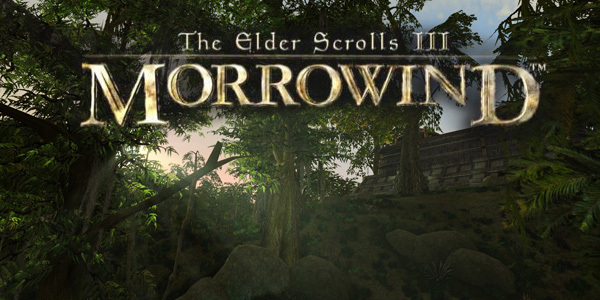
You all heard about Skyrim, right? This particular game is part of a long standing series from Bethesta.
The full name is: ”Elder Scrolls 5: Skyrim”. Before this one there was ”Oblivion”.
Before that we have ”Elder Scrolls 3: Morrowind”. The best game in the series according to many.
But Morrowind is from 2002 and it shows its age. Also the combat is a hot topic
of debate. Some say it is more realistic and less repetative. Others claim it is purly based
on luck and not skill. In fact they are both correct.
But gamers are in luck. Well most of us are. The Elder Scroll series have mostly been built upon a
solid mod foundation. This is one (of many) reason for the long life of the series.
So aging graphics and game mechanics can be corrected. It takes effort and time. But Morrowind
have had both in spades.
So there are alot of mods doing all sorts of things. But the most popular ones improve on sound and
graphics. Quite alot actually. If you put in some time finding and installing the big mods you can make
Skyrim run for its money. Honestly. Morrowind is alot older compared to both Oblivion and Skyrim.
But with mods it can be made to look and sound like you would not believe.
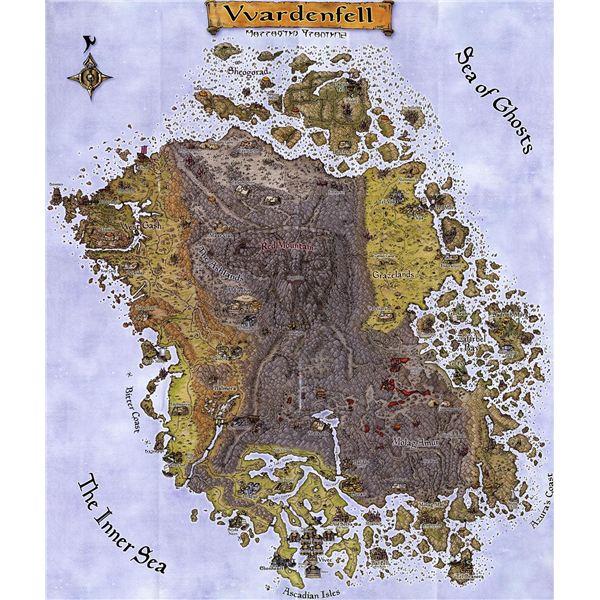
This is the stage on which you are placed in Morrowind. The island of Vvardenfell.
Later expansions added at least one more smaller island to the north.
Some mods add even more.
There are much more land in this province.
But believe me, this quite enough to begin with. There are mods which
try to add the rest but they are not complete. After all it is a HUGE area to begin with.
Also all work is purly fan made.
But the very nature of how Morrowind works as a game makes this island VERY large.
Trust med on this!
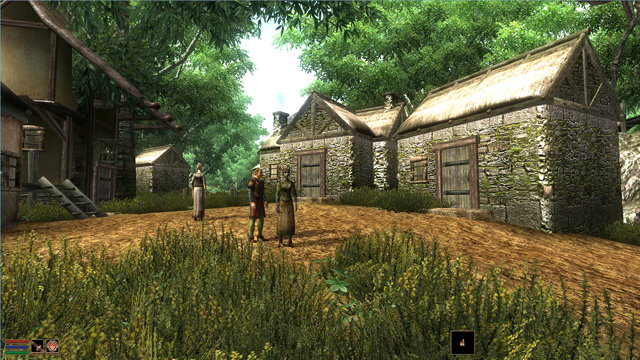
So with mods you can make the game quite the looker.
”Morrowind Graphics and Sound Overhaul” is one of the larger mods.
It is a collection of other smaller modds and extensions.
All aimed at making Morrowind a more modern experience.
Simply adding this package to the game makes an
enormous difference. It like finding the fountain of youth or something.
When I was younger I had a brief encounter with Morrowind.
But as I was not the same person I am today I kind of did not understand the game.
Or what to do in it.
Like all other games in the series this is an open sandbox world.
The player is allowed to go where ever and nearly when ever and in whatever order.
There is a main story, which can be played to an end.
But all the stuff in the between the start and end can easily make you play the game
for hundreds and hundreds of hours. Some people have been returning to Vvardenfell for the last
decade or so. Now that is replayability!
Many will however find that Morrowind is more difficult compared to Oblivion and Skyrim.
Especially if you come directly from Skyrim.
Why? Well, out of all the games (except maybe the first two)
you get a much larger degree of freedom.
But not only that. The game goes out of its way not to hold your hand.
This often comes like a shock to Skyrim players.
The thing about Morrowind is that both combat and dungeon crawling is secondary to exploration.
Finding out about a rich world. A world with living beings in it. Politics and much, much more.
If you can overlook the shortcomings of the game mechanics (or some of them)
Morrowind offers a very large and meaty experience.
The player can expect to find a natural arc in how things work.
This means that you will be VERY, very weak in the beginning.
It also means you have to think before you act.
Learn to walk before you run.
Speaking of running and walking. One of the issues with the game is the speed you move.
With very few exceptions you will find out that you are quite slow in the beginning.
To some players this will probably be a painful experinece.
BUT, this is the cool thing about this game. It changes over time if you stick with it.
So the player will have to get used to being a small time thing in the beginning.
Then the middle part comes along and suddenly things will start to pick up speed.
In every sense of the word. More sub-plots. More quests.
More places to go and much more people to meet.
Even some which are not people at all.
The end game of Morrowind is nothing short of spectacular.
You grow in power like you would not have imagined in the beginning.
You essentially have the potential to become some sort of a deity. Or at least close to it.
Not to mention you will be killing one.
I can not really say more of risk of spoiling the well crafted story of the main quest.
The music is composed, like many other TES games, by Jeremy Soule.
You will find it familiar if you played any of the later games. This is a good thing.
The theme is very nice and forshadows the most excellent soundtrack in Skyrim.
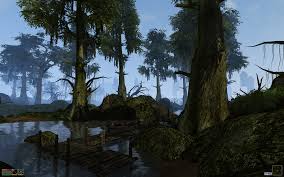
So I’ve decided to take a deep breath and dive into this world.
Yes I know. One more (long time) series is not what I need right now.
But how could I resist?
It will work great as a mirror to Amuens adventures in Skyrim I think.
Also, I want to show of the origin.
Yes there are even older members of the Elder Scrolls saga.
BUT they are very much older (and I quite do not like the way they work).
They are also more primitive and not in the same category (I think)
like the thee latest parts of Elder Scrolls.
I totally ignores the online version. This is like the bastard child of the family.
Everybody knows of its existance but tries to pretend like it never happened
So look forward to this in the future of the channel. I do not exactly know when.
I have already modded the game so I’m ready to start recording any moment now.
It is going to be great!
Late Night Recording...
2015-02-24-14:48
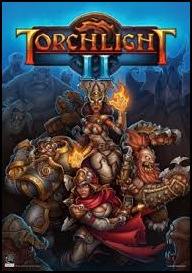
Late last night, which technically is today, I ended recording of Torchlight 2.
It was the first episodes of a new single player series. I liked Fate. I liked
Torchlight 1 even more. Torchlight 2 is the culmination of them both.
As you know, I have been doing a multiplayer series of T2 for some time now.
I’m out of material for this particular series. Since I do not know when
I can record more I decided to do a single player one during the down time.
But it has a twist: it is a maxed out modded Torchlight. Mostly cosmetic but also
some added bonus content and improvements. In short those 10 mods make T2
shine like never before.
I can not say when they’ll get published. Quite alot in the que. But it will be some
time this half of 2015.
As an added side note: Torchlight 2 is now available for mac users! Just like T1.
So why not go get it?
Here is the link - Enjoy!
Torchlight Series Wiki
2015-02-23-15:24
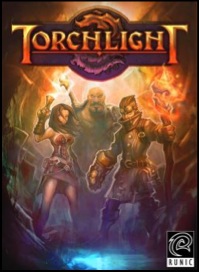

Read the full article HERE!
Torchlight is an action role-playing game developed by Runic Games and published by Perfect World, released for Windows in October 2009.[7] The fantasy-themed game is set in the fictional town of Torchlight and the expansive caverns and dungeons nearby, which adventurers explore to collect valuable loot and battle hordes of monsters.[8] Following the October 2009digital distribution release, a Windows retail box version was released in the U.S. in January 2010 by Encore, Inc,[9] and JoWooD Entertainment published a retail box in Europe in April 2010.[1] A port for OS X was developed by World Domination Industries and released through Steam[10] on May 12, 2010. Runic Games and World Domination Industries developed a port for Xbox Live Arcade which was released on March 9, 2011.[11] A Linux port was released as part of the game's inclusion in the Humble Indie Bundle 6.
Development of the game was led by Travis Baldree, designer of Fate, joined by Max Schaefer and Erich Schaefer (co-designers of Diablo and Diablo II), and the team that worked with Baldree on the original incarnation of Mythos.[12][13] In September 2012, Runic Games released a sequel, Torchlight II, for Windows.[14]
The player controls a lone hero who explores a series of randomized dungeons, fighting large numbers of enemies and collecting equipment, gold, and other loot. The game also features a single town which serves as a hub, to which the player character can periodically return to buy and sell items to NPC vendors and obtain quests.[15] As the protagonist delves into the dungeon, a series of quests are presented which involve battling unique bosses that advance the main storyline. Optionally, the player may take on side quests, random quests or visit branching dungeon areas.[16]The graphics are three dimensional and viewed from an overhead perspective, similar to the isometric perspective used in the original Diablo. On personal computers, the game is controlled using a point-and-click mouse interface and keyboard hotkeys, while the Xbox Live Arcade version uses a controller and has a completely redesigned user interface.[11]
The game generates each level of the dungeon by assembling modular "chunks" of the game environment. Each chunk is designed by hand and may be composed of multiple rooms. They can contain scripted events and interactive objects such as levers that open secret doors or cause bridges to move.[17] This approach to level generation is intended to create dungeons with more purposeful design, instead of environments that simply look like "crossword puzzles that have been extruded upwards."[18]
As in Fate, the player has a permanent pet which fights alongside and can carry and sell loot. The initial pet can be a wolf dog, a lynx or, in the retail version of the game, a ferret;[19] the player can feed fish to their pet to transform it into different creatures.[20]
Also present in the game is a retirement system, in which the player can pass on an heirloom item from an old character to a newly created one, likened to a New Game Plus game mode.[15]
Torchlight features three character classes.[17][20]
- The Destroyer is a wandering warrior skilled in melee combat, although he also has the ability to call upon ancestral spirits to produce magical effects.
- The Alchemist is a spellcaster drawn to the magical power of Ember. He can fire blasts of magic and electricity from his specialized focus glove and can summon imps and steampunk-styled robots.[21]
- The Vanquisher is an elite city guard, sent undercover to investigate the town of Torchlight. She specializes in ranged weapons and can also use traps against her foes.[22][23]
The player develops their character by placing points into class-specific skill trees. Further, there is a separate category of spells that any character can learn from scrolls, regardless of class.[24]
On August 4, 2010 Runic Games announced Torchlight II which will be a continuation of the story, featuring a co-op mode, new player characters, an "overworld" with multiple outdoor areas, and a new user interface.[14][57][58] Although the developers originally estimated a 2011 release, the game was finally released in 2012.[59]
AlienGamer is a donor to Wikipedia Foundation. Are you?
If not, go HERE and put down a donation?
Darwinia Wiki
2015-02-21-15:07
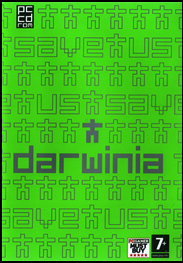
Read the full article HERE!
Darwinia is a 2005 real-time tactics and real-time strategy video game for several platforms. It is the second game developed by Introversion Software, and its setting is within a computer environment that simulates artificial intelligence.
Darwinia was created as a digital theme world for artificially intelligent polygons by Dr Sepulveda. Housed in a massive network of surplus Protologic 68000 machines from the 1980s, Darwinia is a world where the single-poly Darwinians, with their simple, but growing AI, can grow and evolve. Darwinia is also where the world can visit to see them frolicking in their natural, fractal habitat. A Darwinian lives a life working and growing, until the eventual death of the Darwinian, which releases their digital soul to later be reincarnated.
However, the player arrives in the midst of an emergency. Darwinia has been infected by a computer virus, and Sepulveda is in near panic, watching decades of research being corrupted and being used up. Sepulveda enlists the player, a curious hacker who stumbled across Darwinia by accident, to aid him in rescuing the Darwinians and drive off the computer virus. The player is given access to the combat programs, simple tools that originally began as mini-games. These are now the only means of attack against the virus. As the player progresses, it soon becomes clear this is not enough, and that triggers the third aspect of the gameplay, which is evolution.
The first two levels of the video game act as an introduction and allow the player to familiarize themselves with the controls. After that, Dr Sepulveda begins assigning tasks that span several levels to achieve a long-term objective. The first task involves clearing the virus population from and reactivating the Mines and Power Generator to provide resources for the Construction Yard. Once done, the Yard begins producing armored units, allowing the player to move on. The next task involves the reincarnation of Darwinians: the Soul Repository in the center of Darwinia collects the floating souls, and sends them down to the Receiver, where the Darwinians gather them and send them to the Pattern Buffer to be reprogrammed with the main Darwinian blueprint code, where they are sent to the Biosphere to be reborn. The player must clear the Viruses from all the facilities and reactivate them.
In the final level of the game, Sepulveda traces the Viral infection back to its source, which is e-mail spam. After Sepulveda had accidentally flashed an image of his face across the skies of Darwinia, The Darwinians had assumed him to be God. They then re-aligned a portal inside Darwinia in an attempt to communicate with God. The Darwinians managed to access Sepulveda's computer, downloading several files and eventually downloading the Spam. The e-mails were infected with a very nasty strain of internet virus which corrupted the Darwinians. The player is tasked to destroying the few remaining e-mails.
Darwinia mixes elements from strategy, action, puzzle, hacker and God games alike, meaning that it does not fall under a specific video game genre.[1]The player has the ability to run several programs through the Task Manager (a reference to the Windows Task Manager),[citation needed] similar to units used in many real time strategy games. Research allows the player to upgrade programs and weapons, which is critical as the enemy develops. Mission Objectives are given at each location/level, as the player and the Darwinians attempt to wipe out the Viruses.
Darwinia features a number of intros randomly selected when launching the game. These contain a number of references that may be obscure to some players, especially those unfamiliar with older European computers. These include:
- Cracktro text scroller: a spoof of the crack intros that were common among pirated computer games, especially on platforms popular in Europe, such as the Amiga and Commodore 64. The text humorously references both coding for 38 hours straight and finishing the intro in 12 minutes. Allegedly, the release of Darwinia on the Steam platform was delayed for several hours when a Valve employee saw the intro and believed there had been a security breach.[7]
- The Matrix: one intro features green Darwinians dropping from the top of the screen to form a logo, a reference to The Matrix (See Matrix digital rain).
- Real-time Raytracer: another cracktro-style intro featuring a raytraced scene of spinning spheres. This was a popular effect in many old demo scene productions.
- Cannon Fodder: a black screen displaying the text "This game is not in any way endorsed by Sensible Software" while the beginning of the theme from Cannon Fodder plays. The text is a reference to the message that shows at the start of Cannon Fodder, "This game is not in any way endorsed by the Royal British Legion." Some see this as an acknowledgement of Cannon Fodder's influence on Darwinia.
- ZX Spectrum: one of the intros is designed to look like the ZX Spectrum when loading a tape-based game.
- Life: a simulation of the cellular automaton game of Life in which Darwinians live, die and spread in a grid based on just a few basic rules.
- MBTI into: this intro scrolls through the four dichotomies on a Myers-Briggs Type Indicator, listing introversion last as it is the name of the developer.
AlienGamer is a donor to Wikipedia Foundation. Are you?
If not, go HERE and put down a donation?
Update February
2015-02-20-15:14
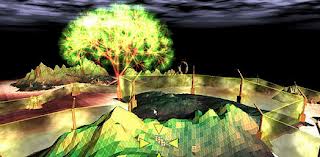
Darwinia 201 SP SWE is out!
Finally we continue our adventure in this excellent indie game.
I really have to many series going. But what to do? I really
enjoy most of these games. It would be a shame not showing
them. I will do my best not to forget anything I’ve started.
BUT some of them will soon be endend. Hopefully this will
lessen the burden
During the meantime I’m busy recording and editing new
episodes from a brand new Skyrim series. I was unhappy
with what I’ve made previously. So I began from a clean slate.
I will not say more than this just yet.
The last week of February (W23) the ”Ethan Carter” series will
pick up where it last left off. This game we will see to the end.
It is qute short so it will be fun.
Oh, and during january and February I have tinkered a bit with the
Youtube front side. It looks alot better now. Or at least different.
I have alot of episodes planned for the future. So have fun,
relax and enjoy the ride!
Also: The Channel can be found at these places too:
Steam Community - Steam Curator